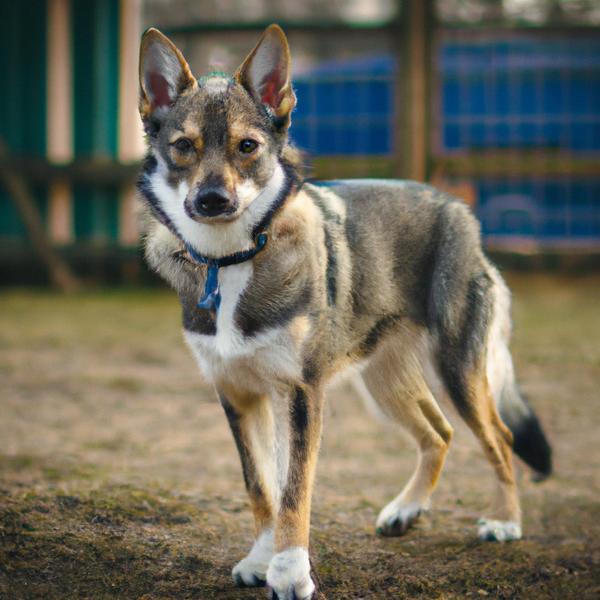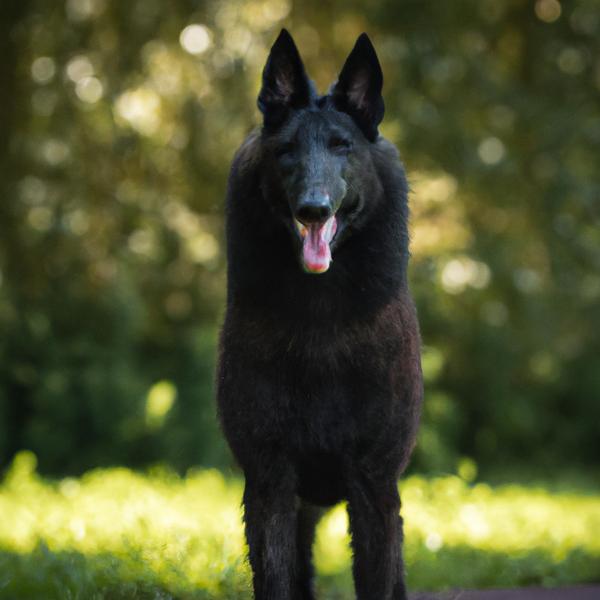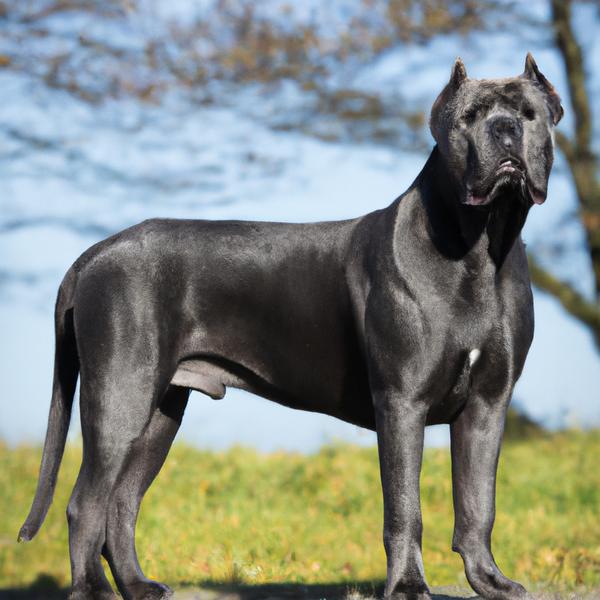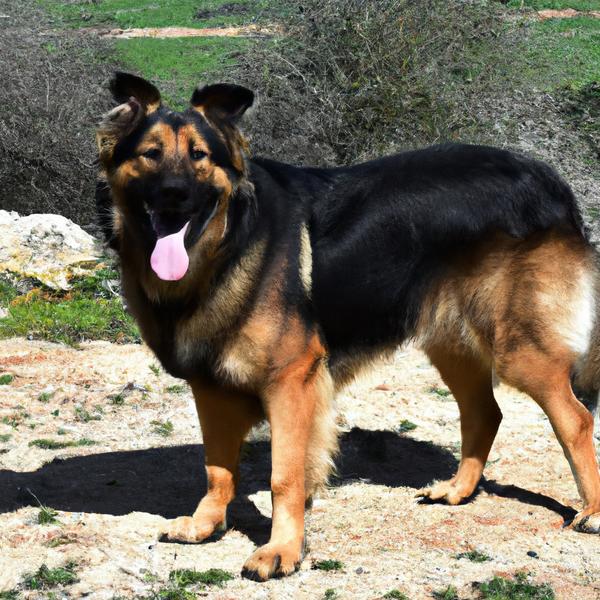Saint Shepherd vs. Blue Blood Cane Corso: Breed Differences and Similarities
Hypoallergenic
Are Saint Shepherds or Blue Blood Cane Corsos hypoallergenic, or neither?
Unfortunately, neither Saint Shepherd nor Blue Blood Cane Corso are hypoallergenic, which may not make them the best choice for dog lovers who suffer from pet allergies.
Temperament
What are the personalities of Saint Shepherd and Blue Blood Cane Corso dogs?
Curious
Independent
Happy
Alert
Courageous
Intelligent
Confident
Friendly
Obedient
Loyal
Gentle
Going
Social
Watchful
Quiet
Loving
Protective
Courageous
Loyal
Social
Trainable
Cheerful
Quiet
Dutiful
Responsible
Shedding Level
Do Saint Shepherds shed more than Blue Blood Cane Corsos, or which breed sheds more, Saint Shepherds or Blue Blood Cane Corsos?
Saint Shepherds shed a lot of hair each year, so frequent brushing is essential for reducing shedding and maintaining coat health.
Blue Blood Cane Corsos are low shedding dogs, requiring minimal coat care.
Origin
What is the origin of Saint Shepherd and Blue Blood Cane Corso dog breeds?
United States
United States
Ancestry
What are the origins of Saint Shepherd and Blue Blood Cane Corso breeds?
German Shepherd, Saint Bernard
Alapaha Blue Blood Bulldog and Cane Corso
Date of Birth
When were Saint Shepherd and Blue Blood Cane Corso breeds first developed?
2000s
Unknown
Litter Size
What is the usual litter size for Saint Shepherd and Blue Blood Cane Corso?
A Saint Shepherd can have a litter of 6-10 puppies on average. However, it's worth noting that the size of the litters can vary greatly. Factors that can influence litter size include the health of the mother, breeding history, and genetics.
A Blue Blood Cane Corso can have a litter of 4-8 puppies on average. However, it's worth noting that the size of the litters can vary greatly. Factors that can influence litter size include the health of the mother, breeding history, and genetics.
Adaptability
Saint Shepherds are highly adaptable and versatile, making them excellent companions for families and individuals of all lifestyles.
Blue Blood Cane Corsos are known for their adaptability and can adjust well to different environments and lifestyle changes.
Health Issues
Between Saint Shepherd and Blue Blood Cane Corso, which breed is more prone to health problems?
The Saint Shepherd breed is generally very healthy, requiring minimal vet visits. Still, it's important to keep an eye on their health and seek veterinary care when needed.
While the Blue Blood Cane Corso breed is generally healthy, occasional vet check-ups are still necessary to address any health concerns.
Major Concerns
What are the major health concerns for Saint Shepherd and Blue Blood Cane Corso breeds?
Hip And Elbow Dysplasia
Renal Cystadenocarcinoma and Nodular Dermatofibrosis
Dilated Cardiomyopathy (DCM)
Gastric Dilation Volvulus (GDV) or Bloat
Entropion
Hip Dysplasia
Minor Concerns
What minor health issues should be kept in mind when owning Saint Shepherd and Blue Blood Cane Corso?
Entropion
Ectropion
Pannus
Keratoconjunctivitis Sicca (Dry Eye)
Allergies
Occasional Tests
What occasional tests are recommended for Saint Shepherd and Blue Blood Cane Corso breeds?
Eye Examination
Skin Evaluation
Blood And Urine Analysis
Diagnostic Imaging
Cardiac Test
Eye
Hip
X-Rays
Physical Examination
Allergy Tests
Social Needs
Saint Shepherd vs Blue Blood Cane Corso social needs comparison
Saint Shepherd and Blue Blood Cane Corso have above average social needs compared to other breeds. They thrive in environments where they have a lot of interaction with humans and other dogs.
Sleeping Need
Which of the two sleeps the most/least: Saint Shepherd or Blue Blood Cane Corso?
Saint Shepherd and Blue Blood Cane Corso breeds are known to have moderate energy levels and normal sleep patterns, typically sleeping around 12-14 hours per day.
Mouthiness
Mouthiness Comparison: Saint Shepherd vs Blue Blood Cane Corso?
Roaming urge
Saint Shepherd vs Labrador: Running away tendency?
Prey Drive
Saint Shepherd or Blue Blood Cane Corso - which breed has a higher level of prey drive?
Activity Level
Which breed has higher energy, Saint Shepherds or Blue Blood Cane Corsos?
Saint Shepherd and Blue Blood Cane Corso are high-energy dogs that require a lot of mental and physical exercise. Without proper stimulation and attention, these breeds can become problematic. If you're considering these breeds, be prepared to invest time and effort in their exercise and training.
Tolerance of being left alone
Grooming
Which breed is easier to maintain in terms of grooming, Saint Shepherds or Blue Blood Cane Corsos?
The Saint Shepherd requires an average amount of grooming compared to other breeds.
The Blue Blood Cane Corso is a low-maintenance breed that doesn't require much grooming.
Brushing Frequency
What is the recommended brushing frequency for Saint Shepherd and Blue Blood Cane Corso dogs?
Ideally, Saint Shepherd should be brushed at least 2 or 3 times a week (preferably daily) improve shedding.
Blue Blood Cane Corso should be brushed at least once a week. Of course you can give them more frequent brushes if you find that they are still shedding a lot
Sensitivity Level
How do Saint Shepherd and Blue Blood Cane Corso compare in sensitivity?
This breed is sensitive to its environment and best suited for patient and understanding families with a consistent routine.
This breed is sensitive and requires gentle handling and a calm home environment.
Apartment Friendly
Which breed is more apartment-friendly: Saint Shepherd or Blue Blood Cane Corso?
Saint Shepherds are good apartment dogs as long as they get enough exercise and stimulation outside of the apartment.
Blue Blood Cane Corsos can do well in apartments with enough exercise and time outside, but a small yard would be ideal.
Child Friendly
Do Saint Shepherds or Blue Blood Cane Corsos have a friendlier temperament towards children?
Saint Shepherds make excellent family pets for kids due to their gentle, protective nature and calm temperament.
Blue Blood Cane Corsos are good with kids if socialized and trained from a young age.
Senior-friendly
Which dog is more suitable as a pet for the elderly - Saint Shepherd or Blue Blood Cane Corso?
Cat Friendly
Do Saint Shepherd or Blue Blood Cane Corso breeds have a better compatibility with cats?
Saint Shepherds are good with cats, but early training is needed to prevent chasing behavior.
Blue Blood Cane Corsos are somewhat cat friendly and can be trained to get along with cats.
Dog Friendly
Which breed is more sociable with other dogs: Saint Shepherd or Blue Blood Cane Corso?
Saint Shepherds are friendly and active companions, and can be good family pets, though their friendliness towards other dogs may vary.
Blue Blood Cane Corsos are less friendly towards other dogs, but can improve with socialization.
Pet friendly
How do Saint Shepherd or Blue Blood Cane Corso dogs interact with other pets?
Stranger Friendly
Which breed is more friendly with strangers: Saint Shepherd or Blue Blood Cane Corso?
Saint Shepherds are friendly but may bark at strangers, and training is easy due to their intelligence.
Blue Blood Cane Corsos are not very stranger friendly.
Playfulness
Which breed is more playful between Saint Shepherd and Blue Blood Cane Corso?
Saint Shepherd and Blue Blood Cane Corso have an average level of playfulness. Like other dogs, they enjoy playing, but they are not the most playful dog breed.
Trainability
How do the trainability levels of Saint Shepherds and Blue Blood Cane Corsos compare?
Saint Shepherds are usually easy to train but require consistency to fully obey commands.
Blue Blood Cane Corsos are popular for their ease of training and quick learning ability.
Compare Saint Shepherd with other breeds

Pughasa
Saint Shepherd vs Pughasa

Swedish Vallhund
Saint Shepherd vs Swedish Vallhund

Austrian Pinscher
Saint Shepherd vs Austrian Pinscher

Bolo-Chi
Saint Shepherd vs Bolo-Chi

Rott Pei
Saint Shepherd vs Rott Pei

Belgian Sheepdog
Saint Shepherd vs Belgian Sheepdog

Schnau-Tzu
Saint Shepherd vs Schnau-Tzu

German Pinscher
Saint Shepherd vs German Pinscher

Blue Blood Cane Corso
Saint Shepherd vs Blue Blood Cane Corso

Schnocker
Saint Shepherd vs Schnocker

Coton-Beagle
Saint Shepherd vs Coton-Beagle

Wowauzer
Saint Shepherd vs Wowauzer
